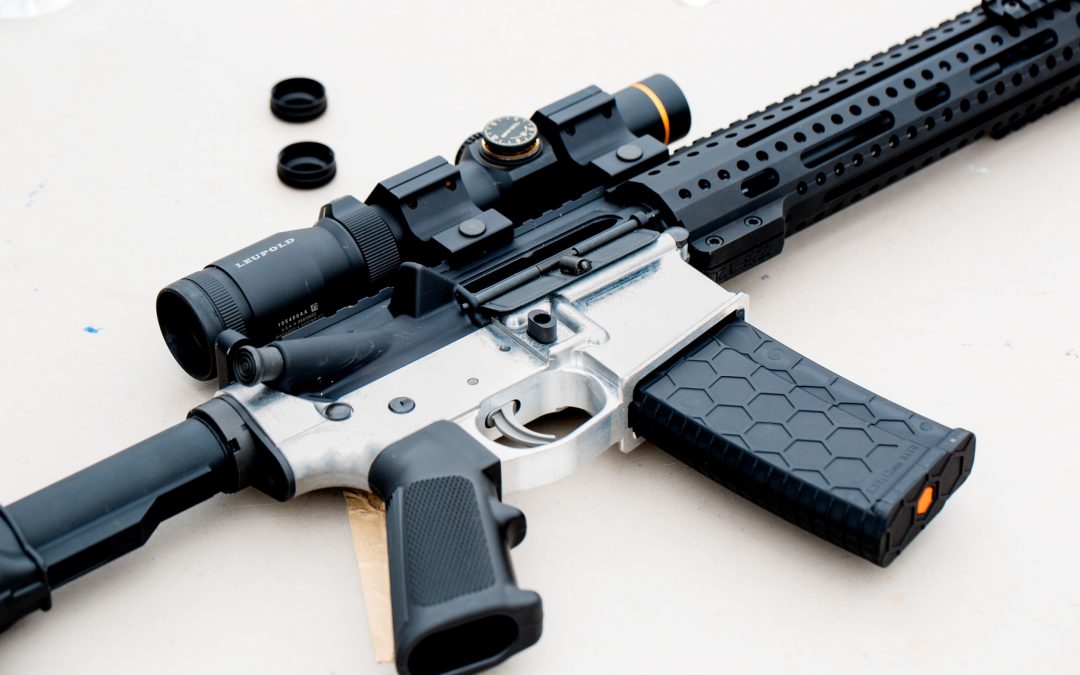The phrase “ghost gun” evokes spooky, sinister, and seedy-underground images of nefarious types doing Bad Things, especially in the minds of folks who aren’t well versed in firearms knowledge and/or suspicious of guns in general. It’s one you may have heard voiced, with appropriately “concerned” inflection, by some talking heads on a news program. And, I expect, it’ll be one you’ll hear more often should some form of gun prohibition regarding “assault weapons” get enacted.
The reality is more mundane and, to the disappointment of ectoplasmic warrior wannabes, has nothing to do with dispelling apparitions from the nether world. A ghost gun is simply a home-made firearm, without a serial number or other identifying markings. In all but a few states in the US, they are legal to own, provided the owner is not otherwise debarred from owning guns (e.g. because of a felony conviction). They cannot be sold legally – any firearm sold must have identifying marks – but they can be made for personal use.
This distinction is the product of some basic truths. A hunk of steel is not a gun, but it can be turned into a gun with the aid of some skill and some machine tools. At some point during the process of making a not-gun into a gun, the not-gun becomes a gun. To properly enforce the laws regarding markings/serial numbers, someone has to decide at what point in the manufacturing process a not-gun becomes a gun. The government has done so. First, it specified that the core part of a firearm, the receiver (to which everything else attaches), is the part that’s to be serialized. Second, it specified that a receiver must be serialized when it is more than “80% complete,” with technical details as to what that means delineated.
The nature of human existence guaranteed the emergence of a market for “80% receivers,” in particular for rifles in AR-15 format. And, it guaranteed the emergence of instructions as to how to complete those receivers. The balance of parts required for the completion of a firearm build, being unrestricted, can be purchased without going through the process required for purchasing a functional firearm. So, any person motivated to do so can, provided he has some basic ability to use tools, build a “ghost gun.”
Again, this is perfectly legal in all but 5 states.
And, naturally, this freaks out gun control types, because a ghost gun that is used in a crime cannot be traced back to a purchaser.
Advancing technology has increased the ease with which ghost guns can be made. The earliest wave-maker is a gun rights activist named Cody Wilson, who developed several designs for guns that could be made with relatively inexpensive 3D printers, and released those designs onto the Internet. Since then, designs for making 80% receivers on consumer-grade CNC milling machines have been developed and released. This is all out there now, with the permanence of the Internet, so it’s a genie that cannot be stuffed back into the bottle.
Ghost guns, for all their untraceability, are only rarely used in the commission of crimes (although they’re becoming more common in California. Where they’ve been banned. Imagine that). Nevertheless, they’re of high concern to gun control advocates and those of regulatory bent because, I presume, those folks don’t like the idea of not having knowledge and control. So, we witness the bans (of recent vintage) in 5 states, and we witness a step further in Pennsylvania’s recent declaration that an 80% receiver is a firearm, and thus requires a background check for purchase.
While criminals using untraceable firearms clearly makes law enforcement’s job more difficult, believing a legislative or regulatory remedy exists is tilting at windmills. Technology has already made such efforts futile for stopping someone with sufficient will, and more restrictions are likely to exacerbate, rather than remedy, the problem.
It doesn’t take a whole lot of imagination to envision an enterprising individual buying a CNC machine and some other tools and churning out AR-15 lower receivers in bulk in his basement. And, if government decides to try and regulate the other parts of an AR-15 (how do you regulate a piece of pipe, by the way?), it’s inevitable that either that machinist or another one will start making those regulated parts as well.
Or, to partake of other offerings in the market, as this NYTimes reporter did by mail-ordering everything he needed to make a Glock 19 pistol, including parts and various kits, tools, and jigs. As with the AR-15, he had to complete manufacture of the lower receiver (which is plastic). It took some work on his part, but no super-special or expensive tools, and about 6 hours of work.
One needn’t have criminal intent to want to possess a firearm in the face of looming bans to want a firearm. During the Obama years, where there was widespread fear of new prohibitions, firearm sales skyrocketed, with the number of newly manufactured guns growing from about 3M a year under GWB to over 10M a year in 2013. In the past 30 years or so, the number of guns in America has increased from about 250M to over 420M. That only a tiny, tiny fraction of these are ever used for criminal purposes tells us that the vast majority of those buying guns in fear of future prohibitions are law-abiding citizens. That some politicians would turn these law-abiding citizens into criminals with the stroke of a pen (Beto O’Rourke promised to take 15 million AR-15s away from citizens were he to become President) should scare the bejeezus out of us.
Whether or not you think ghost guns should be banned is beside the point. The question at hand boils down to one word: “How?” How do you stop people from making guns at home, especially given the ever-increasing accessibility of consumer-grade tech that can be used to make them? You can’t ban general purpose tools and machines, and you can’t ban steel or plastic. Yes, you can make the act of manufacturing such a firearm illegal, but will a criminal care?
Furthermore, by making legal gun ownership more difficult (or, taken to the extreme) impossible, the government would induce what has always come into existence under prohibitions, of many sorts, throughout human history: a robust black market. Make AR-15s illegal, and I guarantee that the gun-making equivalent of meth labs will sprout like mushrooms across the country. Right now, people who want them buy them, with serial numbers and background checks, because it’s not that hard to do. Make it prohibitively difficult and, yes, some won’t bother (but what are the odds that those folks would have criminal intent in the first place?) but others will, if only as a ..!.. to the government.
Richard Cowan’s Iron Law of Prohibition posits that as law enforcement becomes more intense, the potency of prohibited substances increases. In the case of firearms, heavier prohibition could easily lead to a black market that produces full-automatic rifles (which are used so rarely in crime today in America as to be in the statistical noise).
The NY Times reporter’s piece on making the Glock 19 skates by the “how?” question, suggesting that requiring background checks for the 80% lower receiver kits is a good idea. But, just as the market responded to the 80% line of demarcation, it’ll respond to any other obstacle. Guns are, after all merely assemblies of metal, plastic, and/or wood. The time and effort required to complete a build is more than most people are willing to go through, so most people just buy their guns the normal way. But, any notion that ghost guns can be banned merely with new laws and regulations is a departure from reality. Can the government effectively impose the equivalent of a surveillance state on all CNC machines and all hunks of aluminum or steel? Color me skeptical.
To demonstrate this even more fully, consider the matter of plastic guns. Still in relative infancy, and of lesser reliability/durability, the plastic gun, the first creation of Cody Wilson’s Defense Distributed, simply cannot be legislated out of existence, since all it requires is a 3D printer that costs a few hundred dollars. These are currently novelties, but prohibition will only serve to motivate clever and enterprising pro-liberty people toward improved designs and processes.
In short, banning guns will only serve to create a bigger market in ghost guns, and make law enforcement’s job harder, not easier.
The hype regarding ghost guns is political opportunism. Induce fear in the populace, then pile on misinformation and disinformation, in order to get the voters to give up their rights, all in a response to a “threat” that’s in the statistical noise. Furthermore, those who believe they’re getting ahead of the problem ignore their solutions’ uselessness. It’s already illegal to sell a ghost gun. Making it illegal to make one accomplishes – what, exactly? – in preventing crime? Who is it going to stop? The technology cannot be uninvented. All the bans will do is allow preening politicians to say they “did something,” even though that something is worse than doing nothing.


Makes me think of the Connecticut Yankee in King Arthur’s Court. with CNC machines and the like a Colt should be know problem. The obsession with high capacity magazines may keep revolvers legal, but how long before CNC machines have to be registered.
Though as you alluded older technologies can suffice, lets face it when was the first 1911 made…
Already seeing the next target is going to be ammo…
They might get away with that for a while in a deep blue state, but not nationally. Unless they tip SCOTUS super-blue, that is…